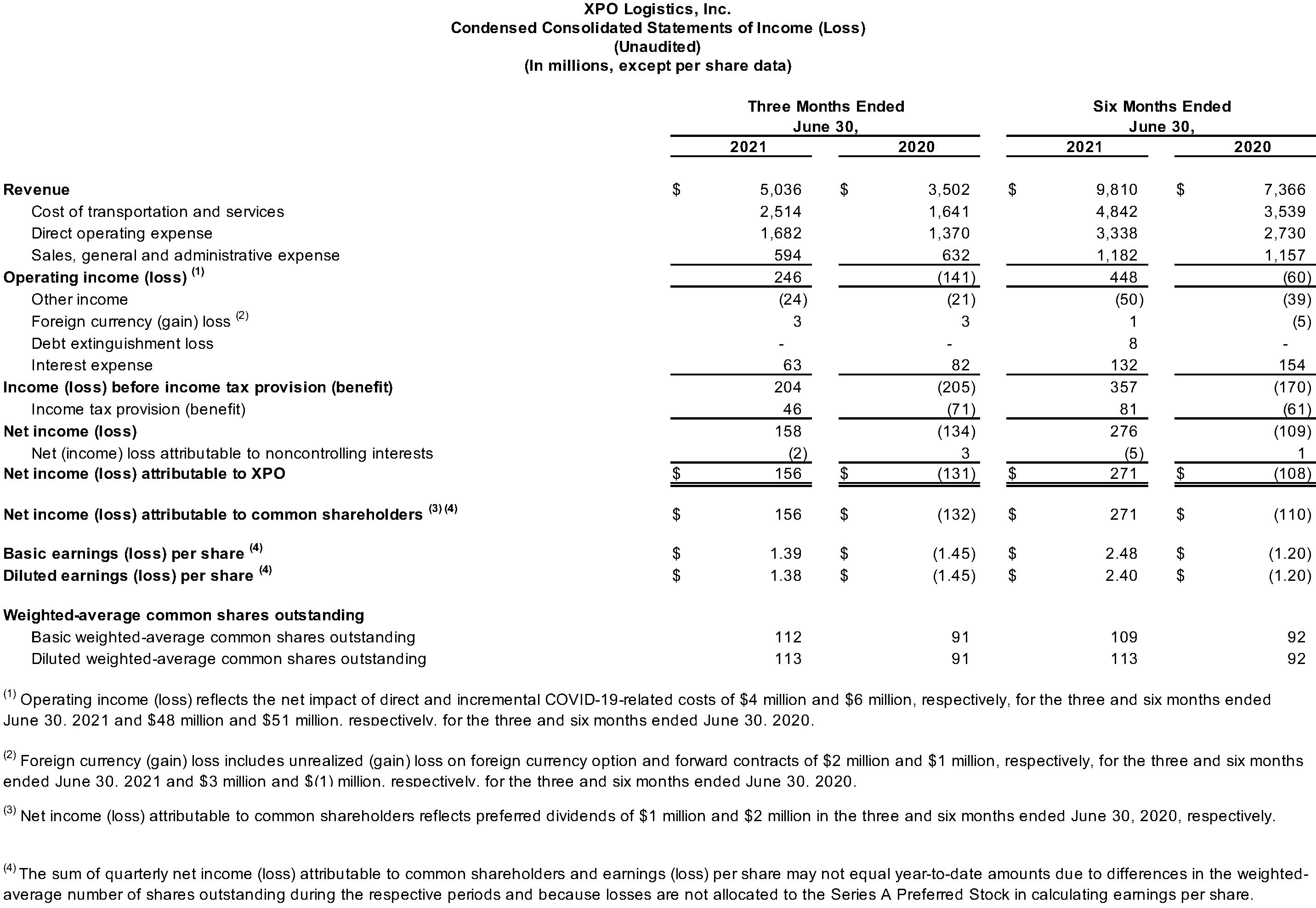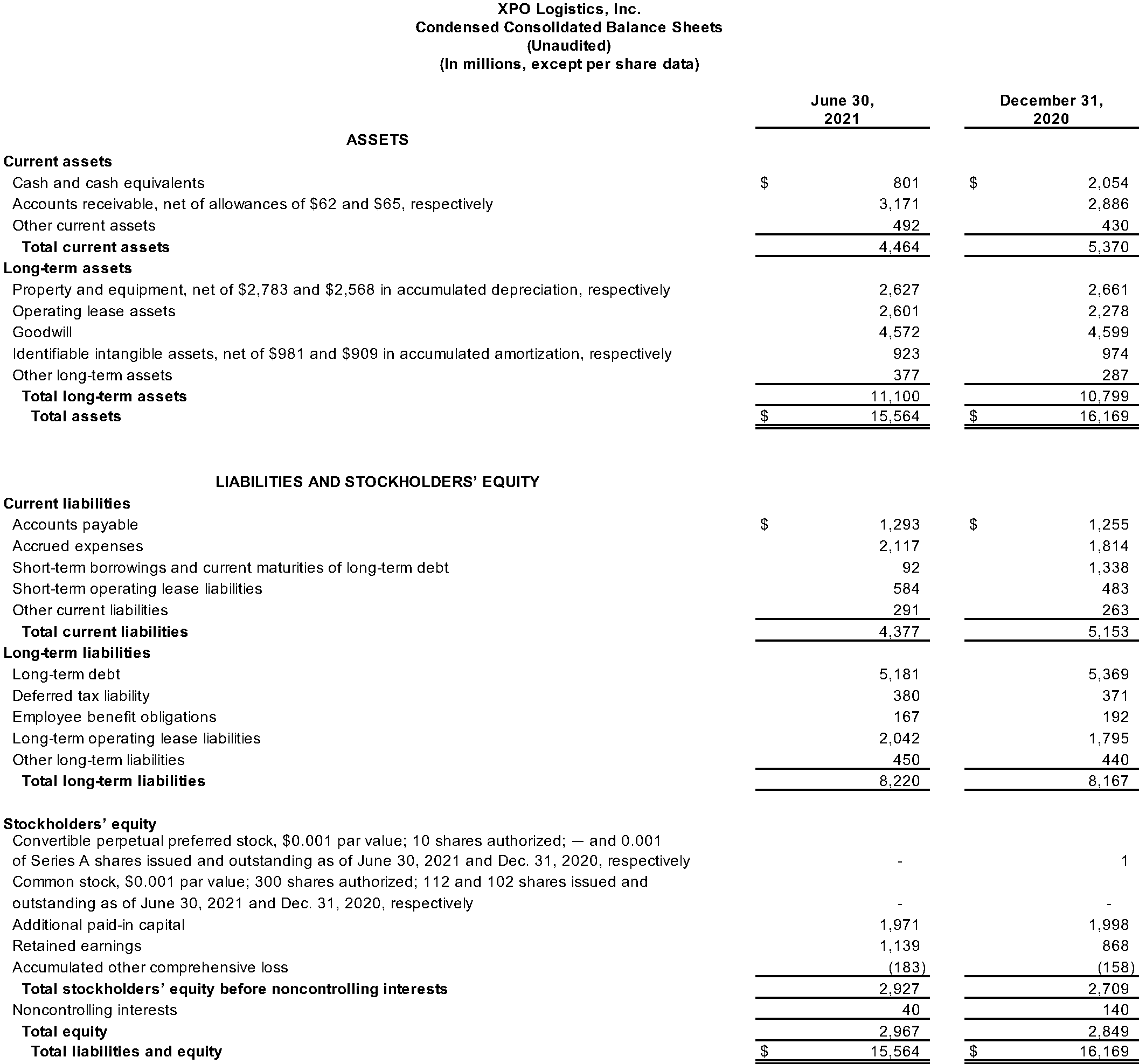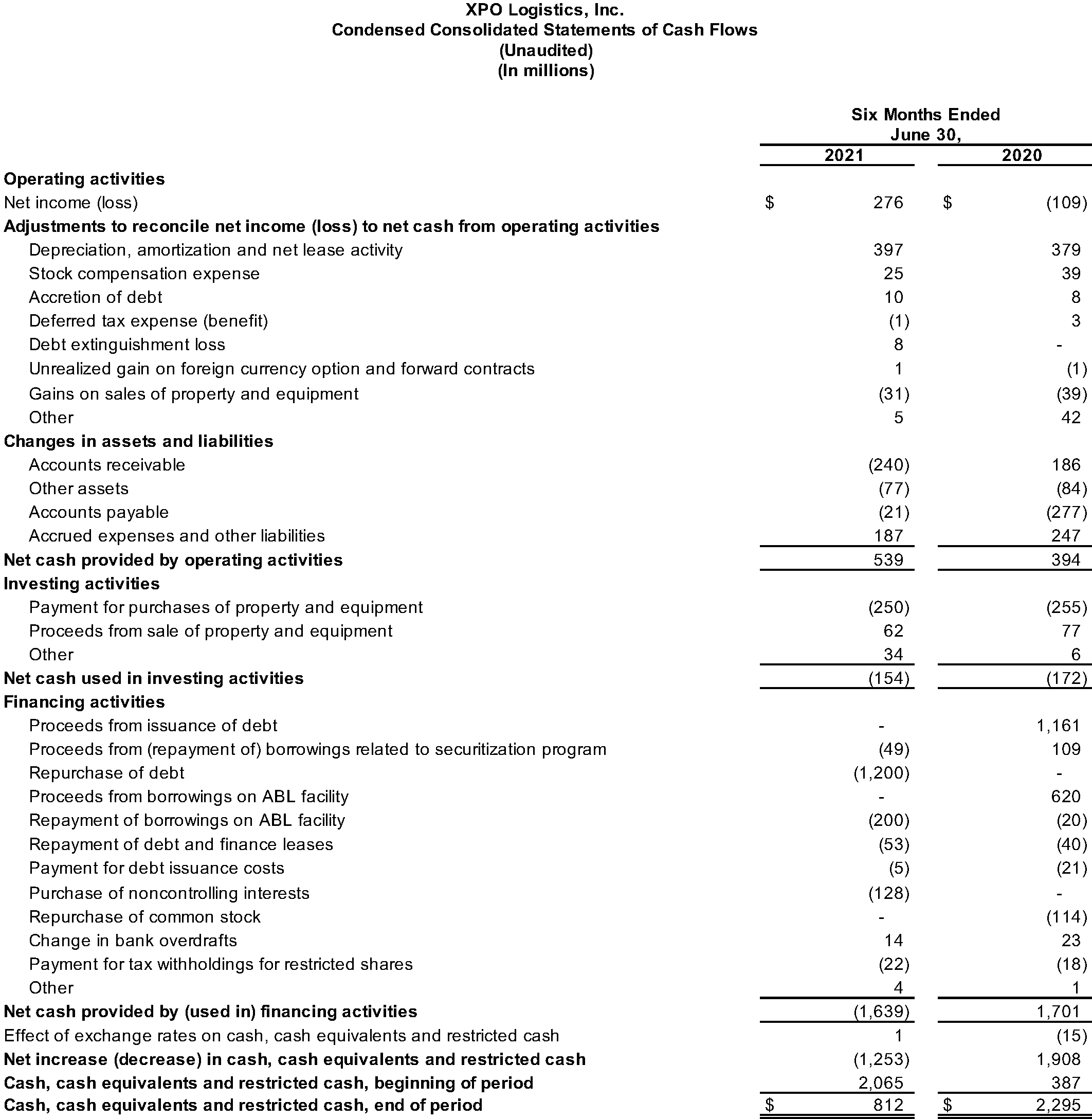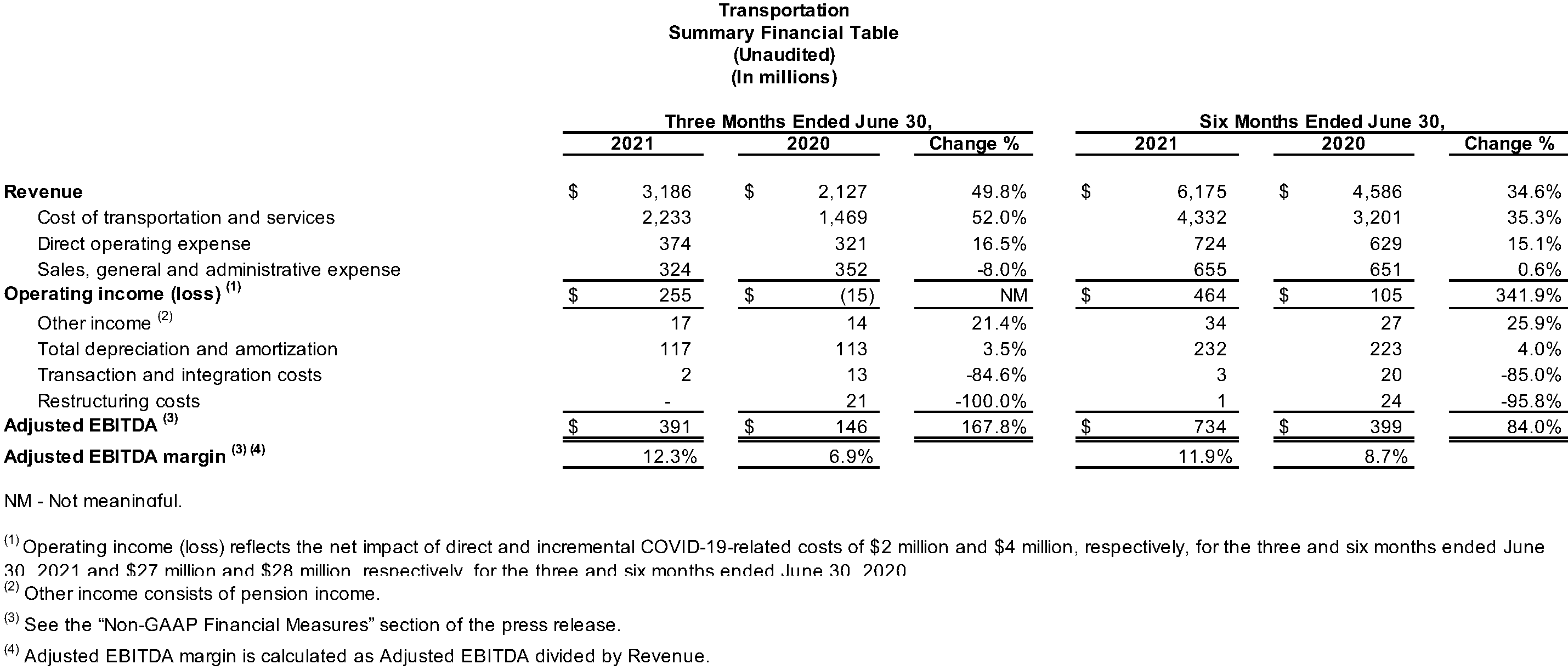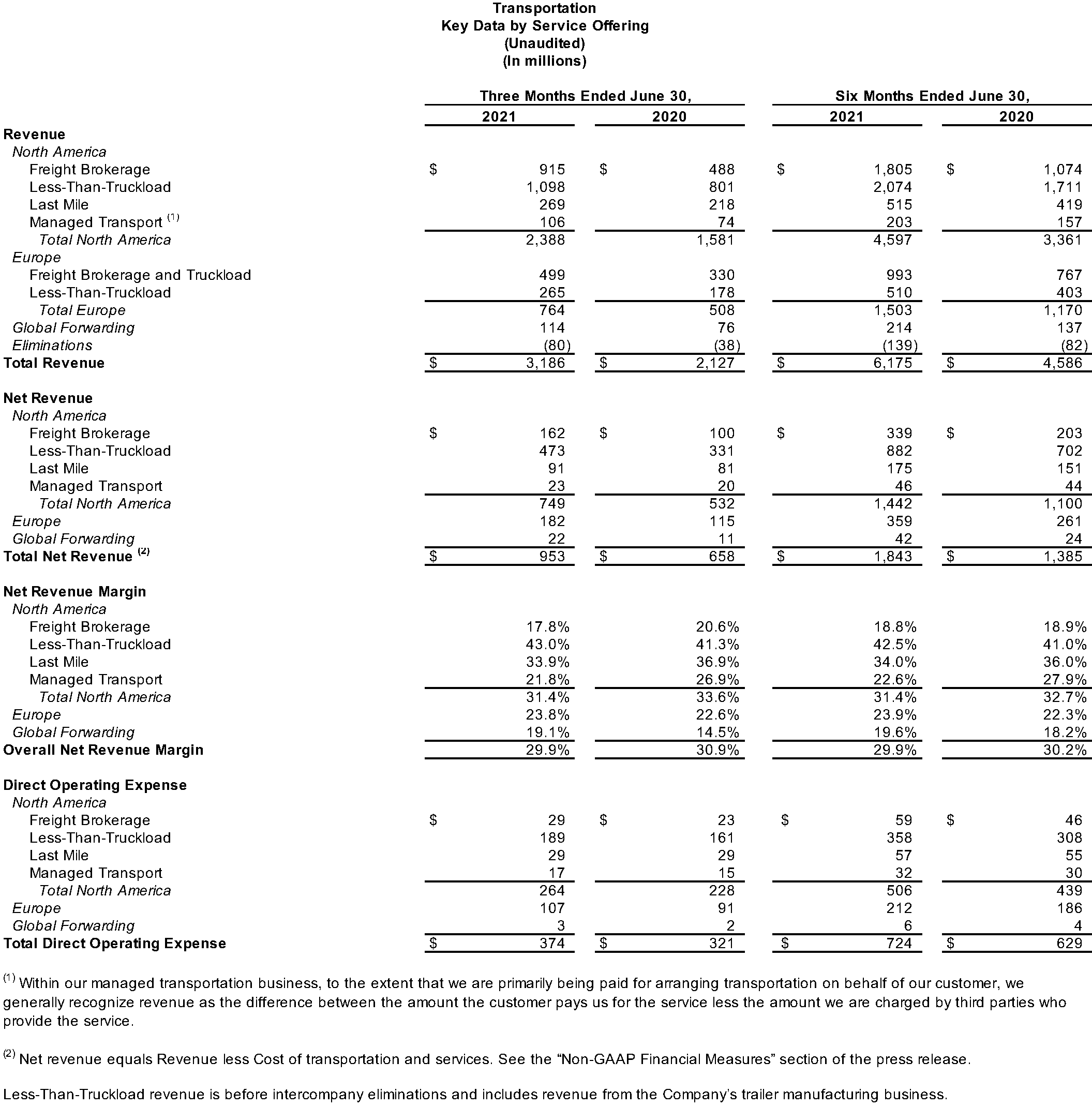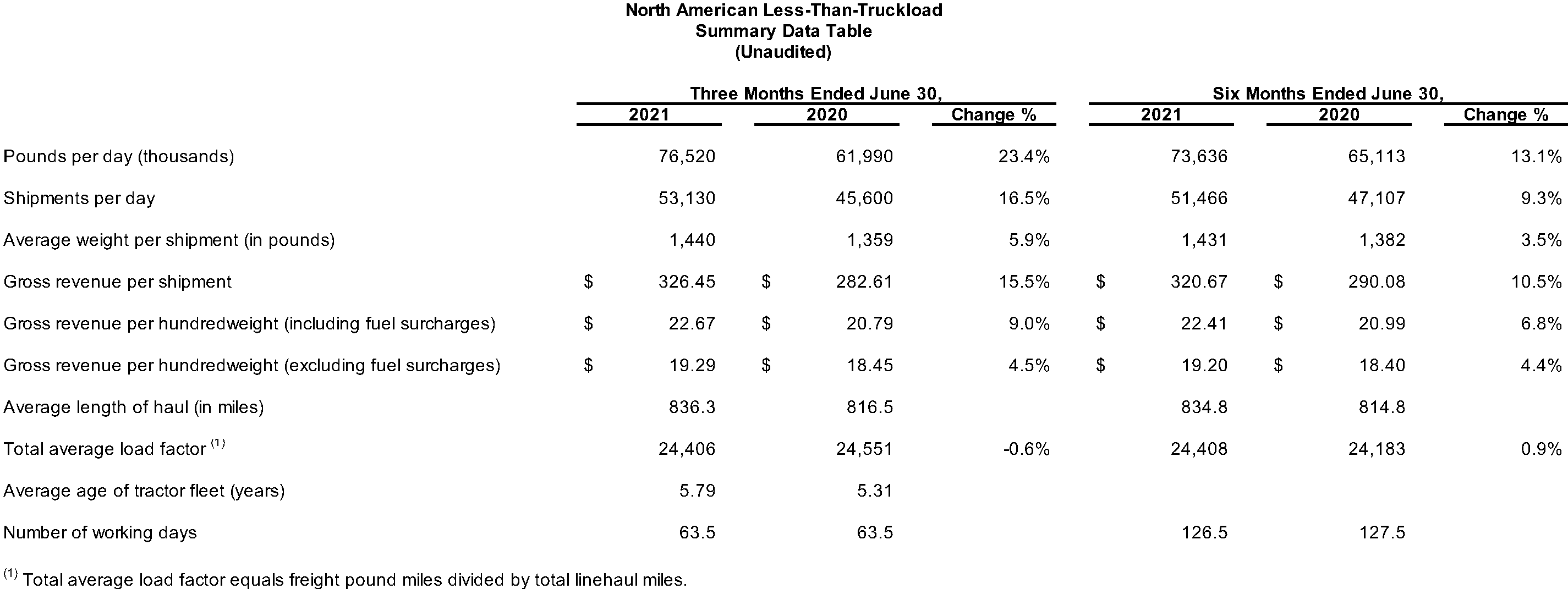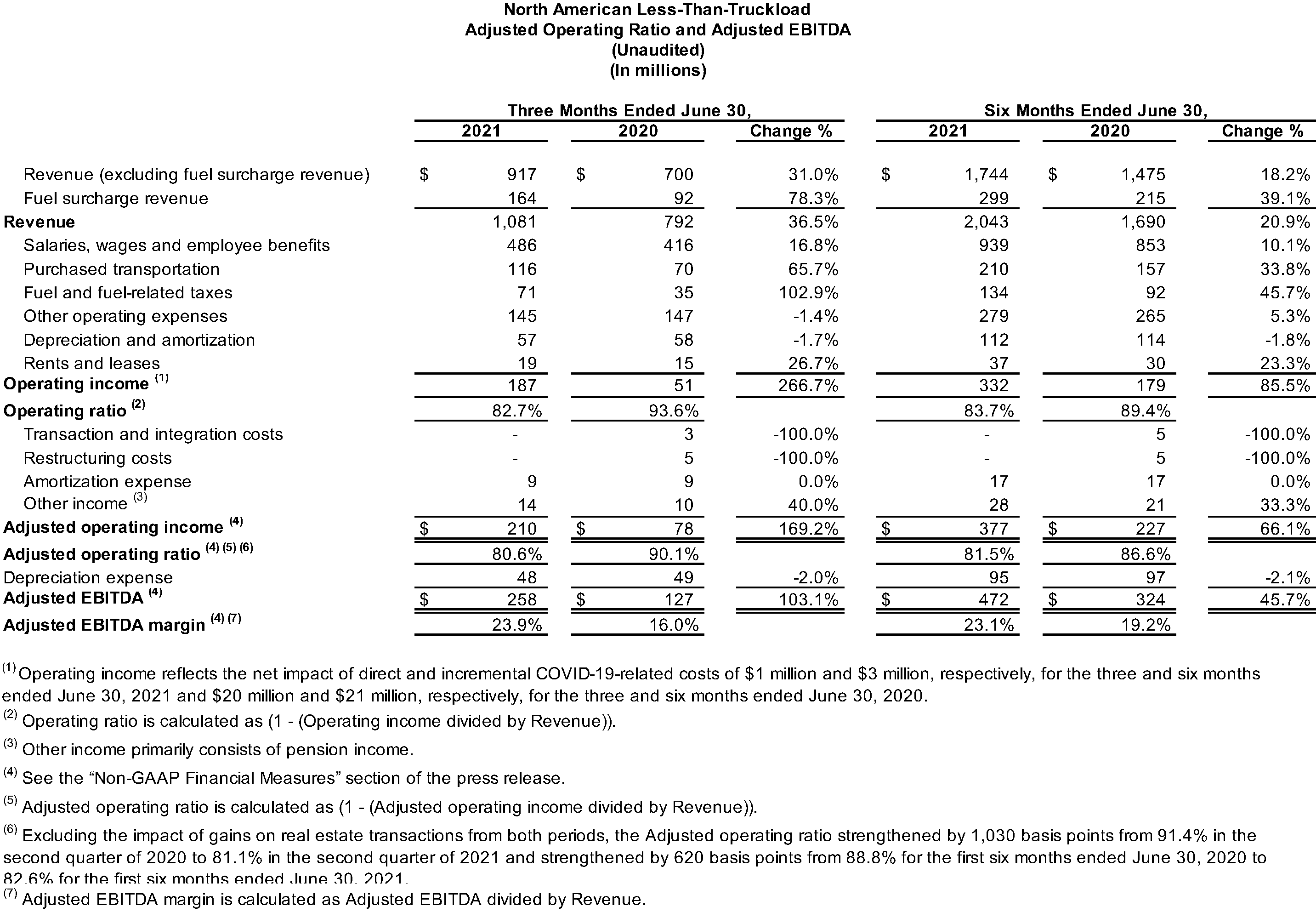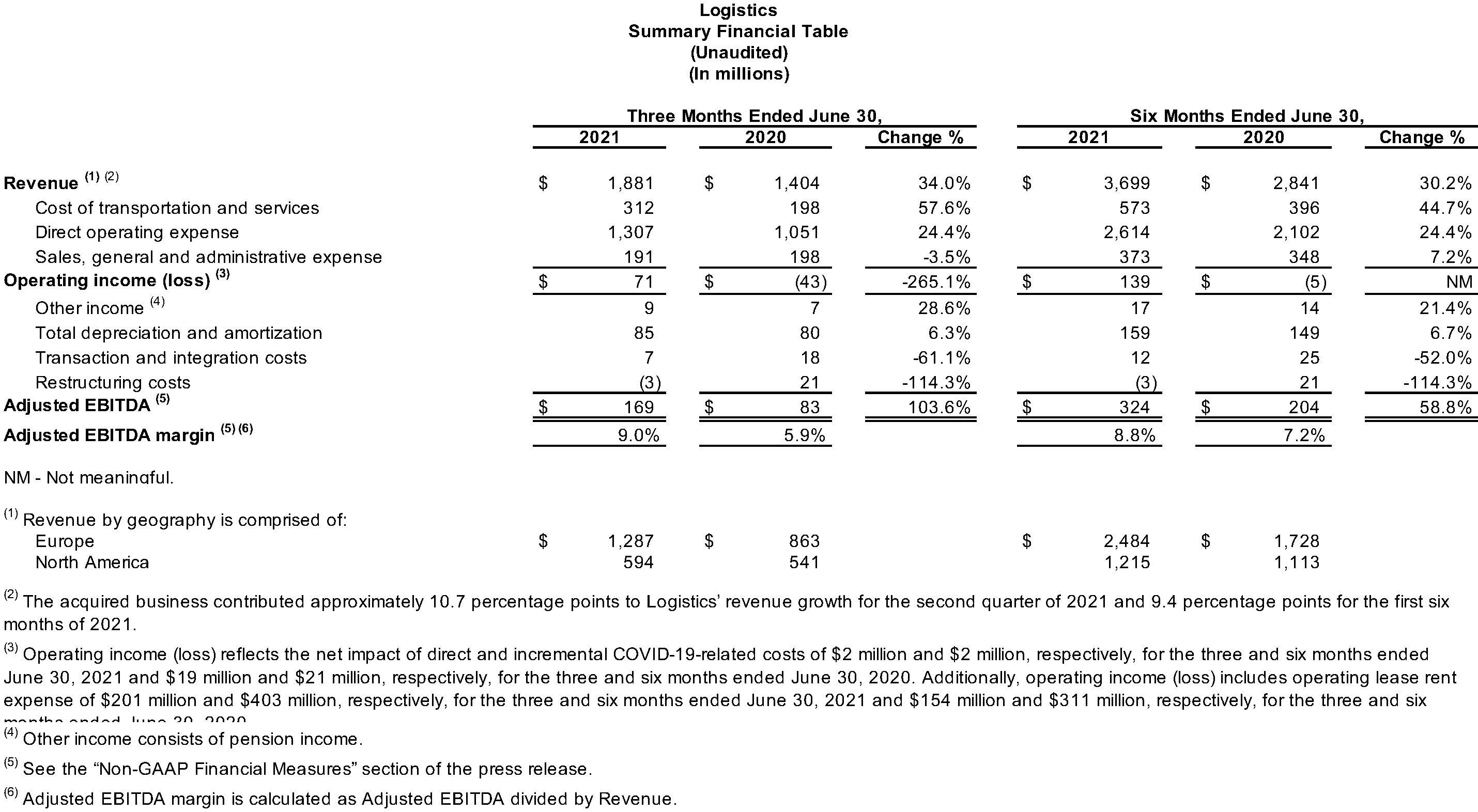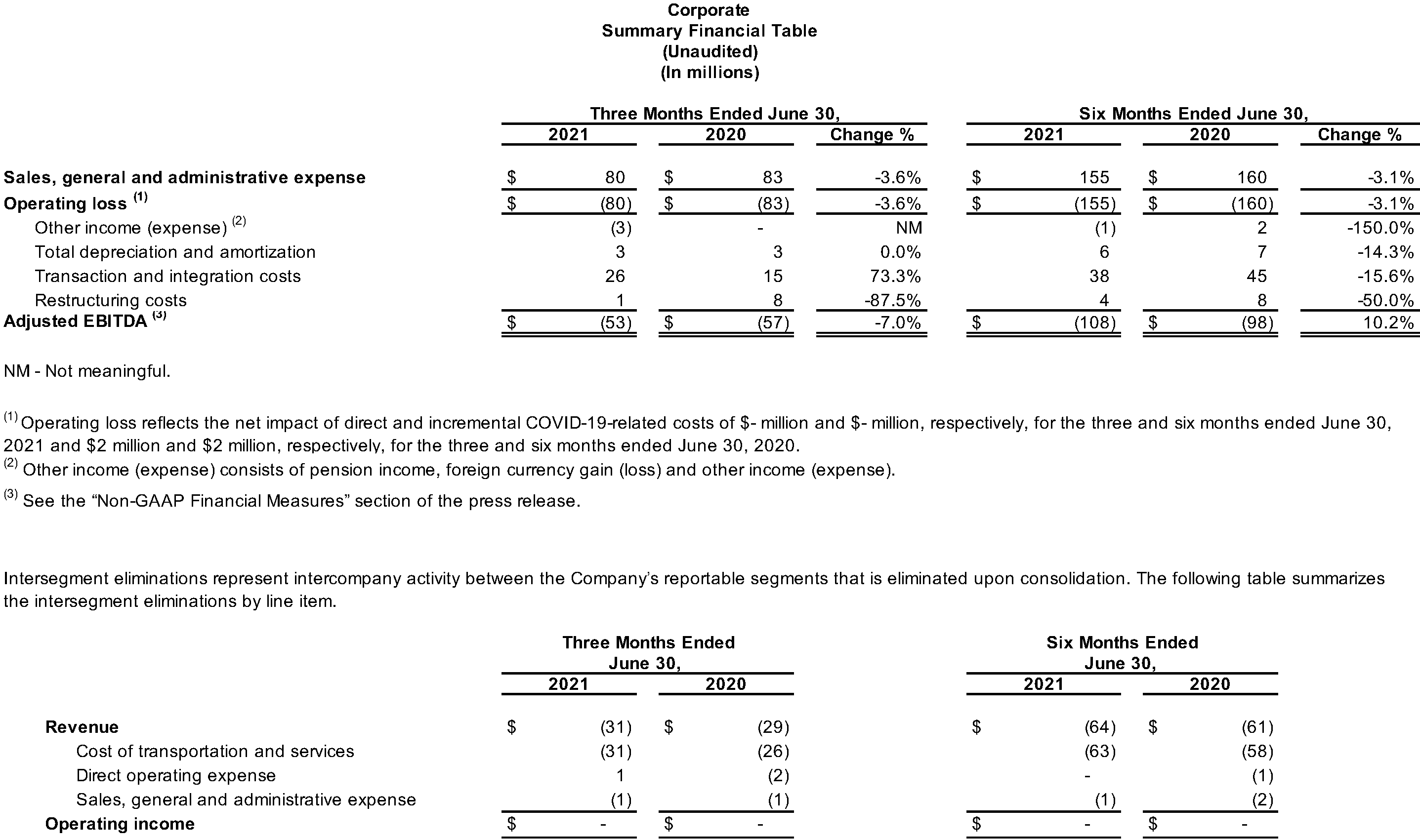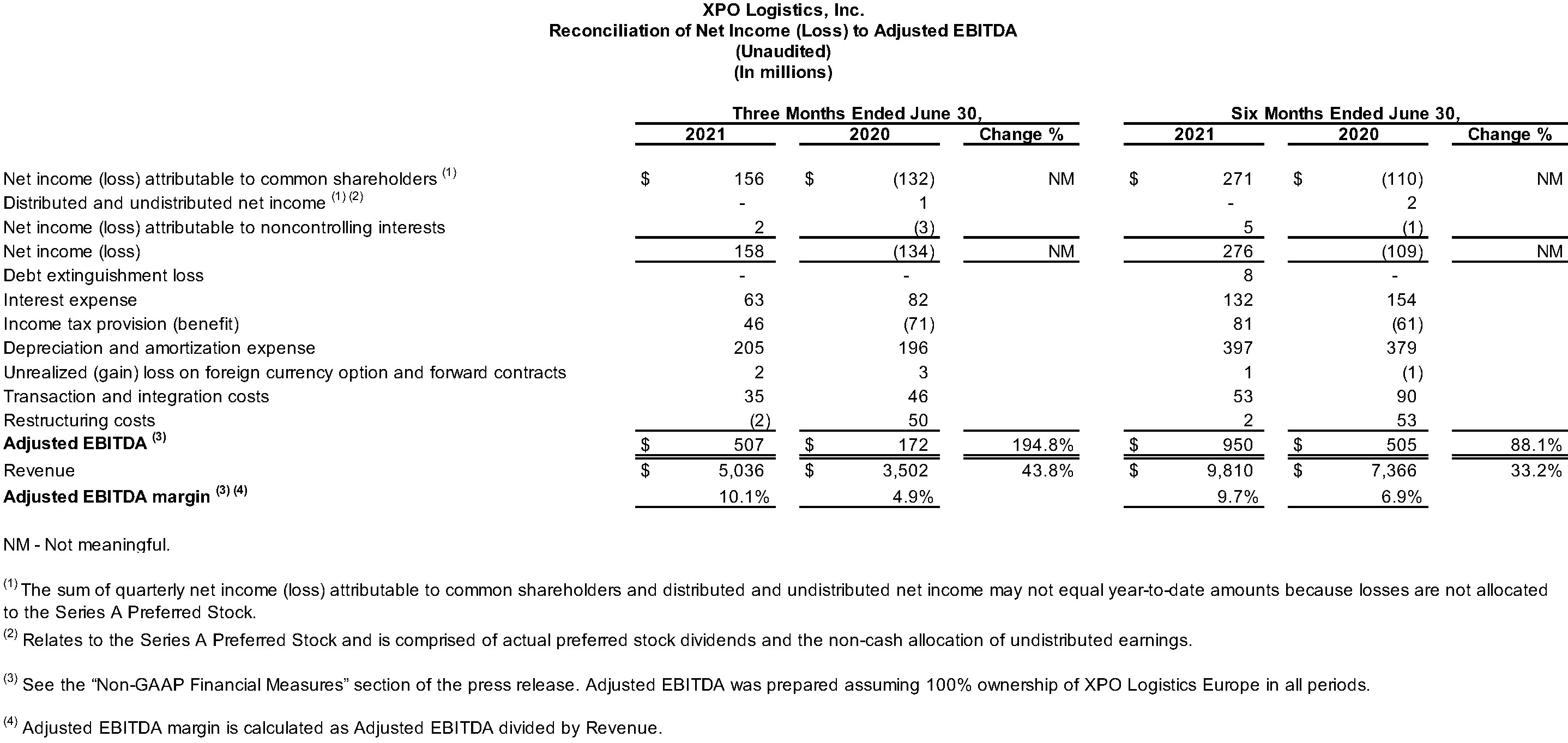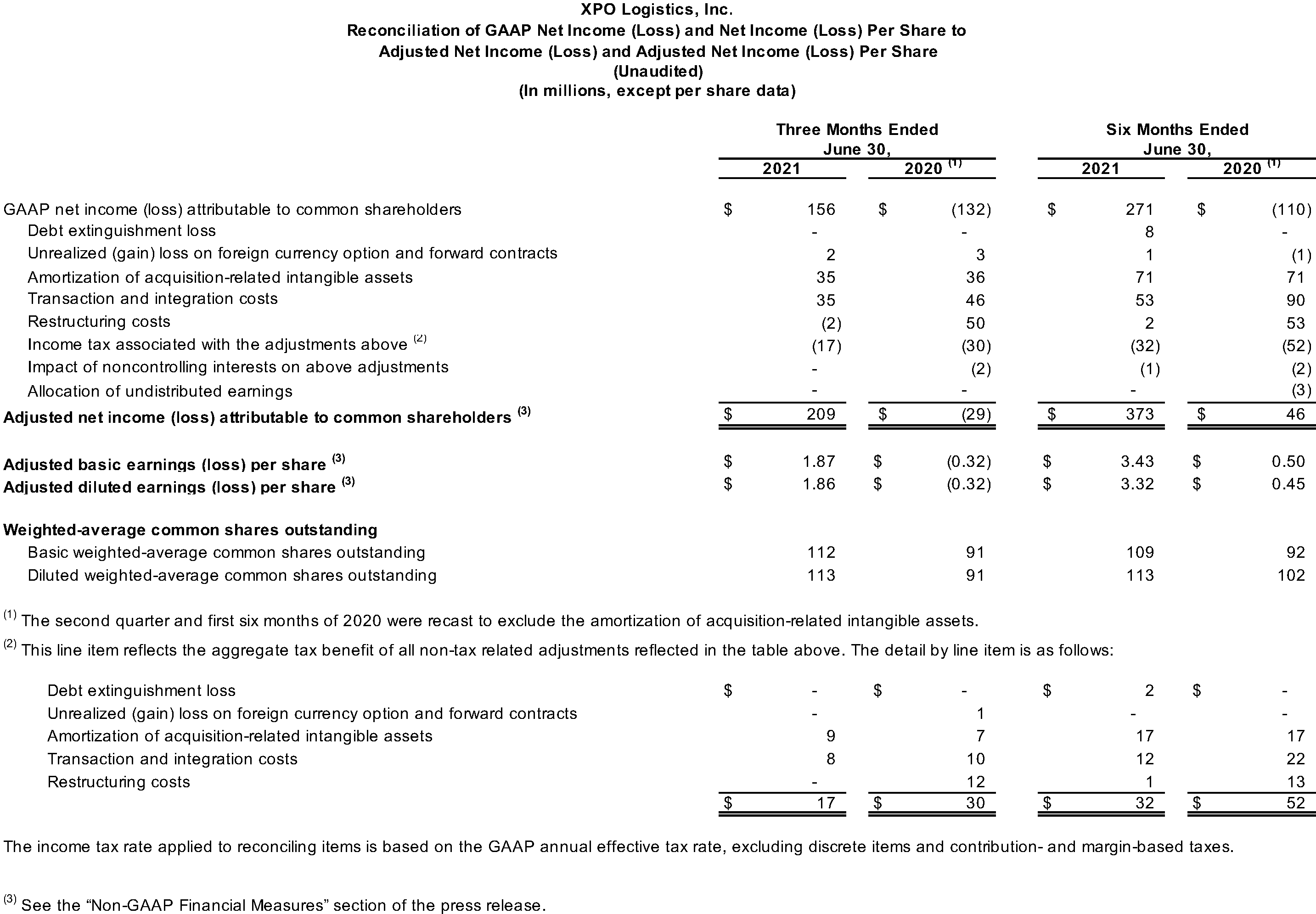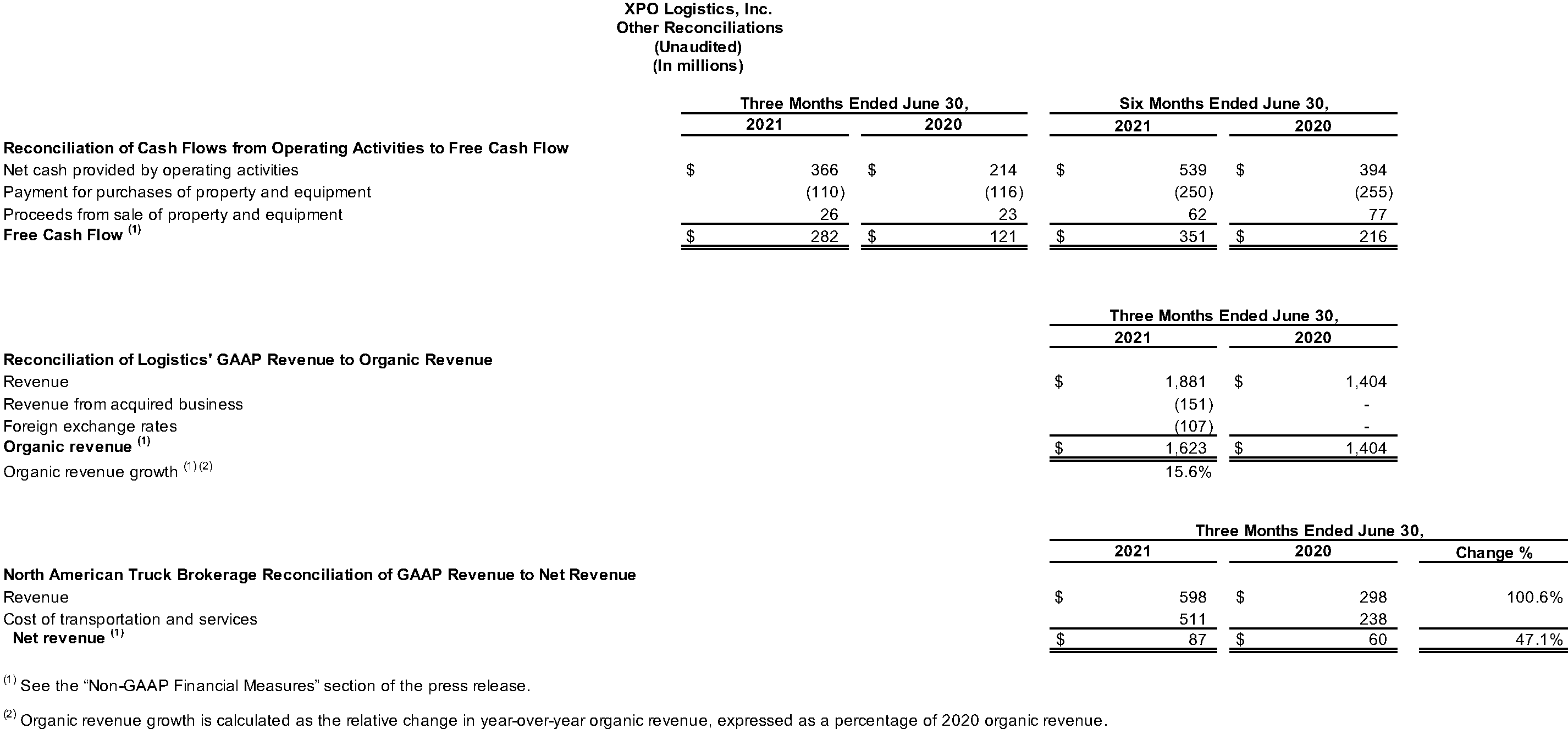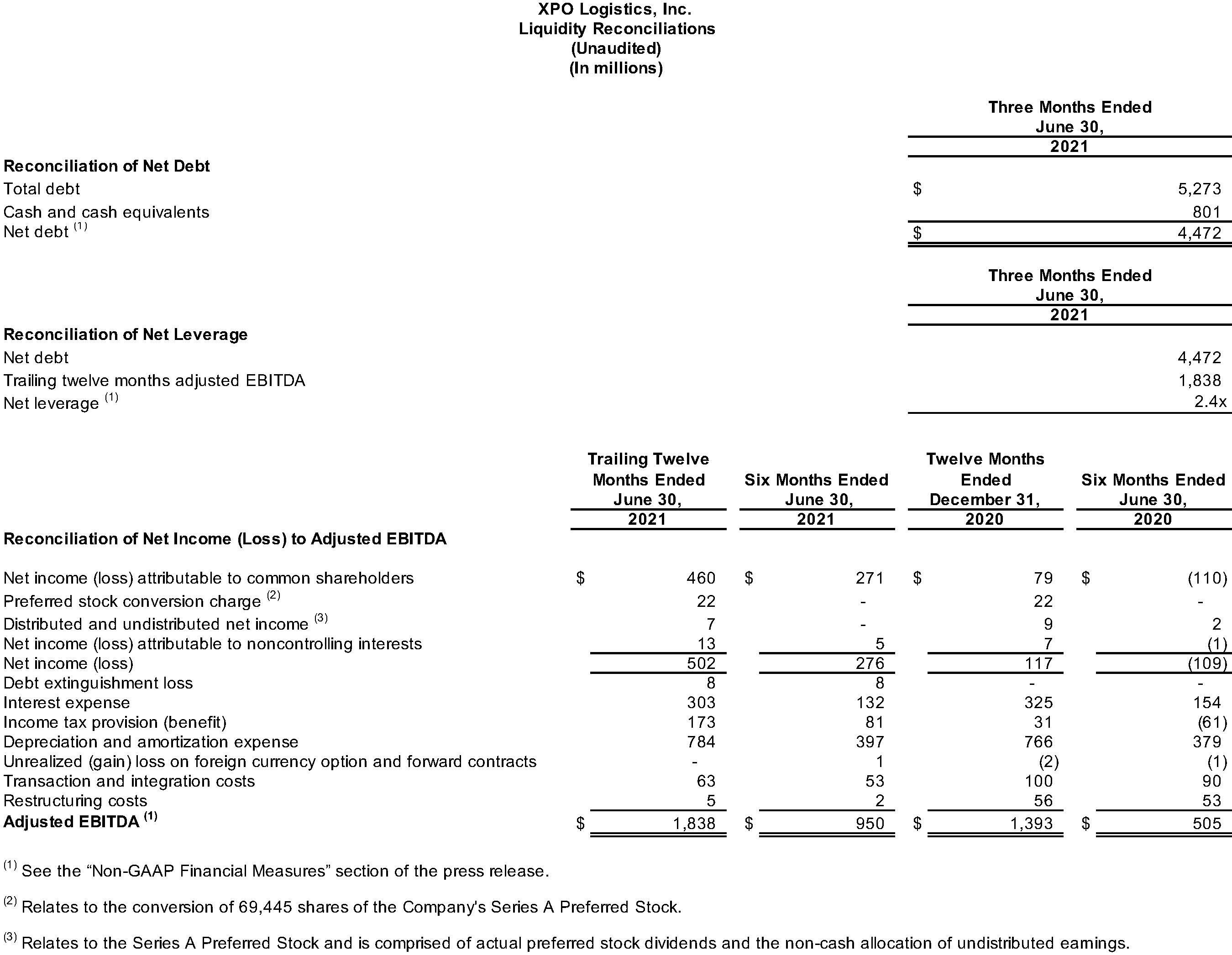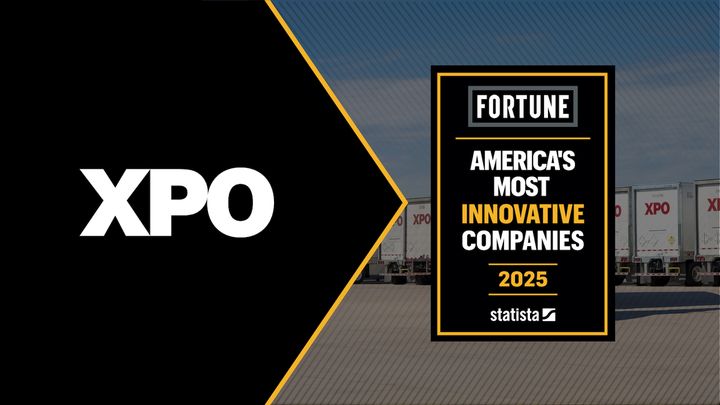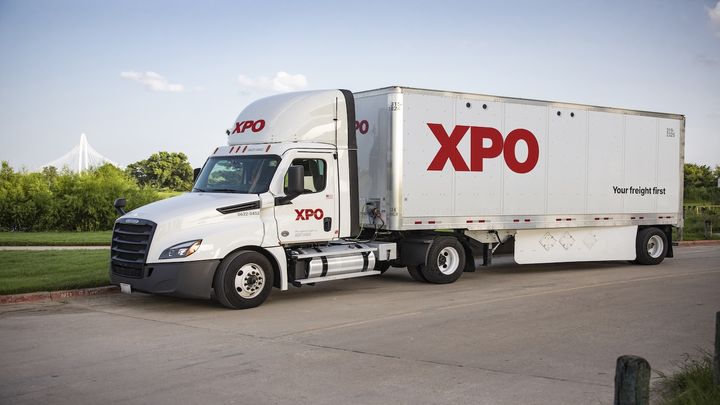XPO Logistics Announces Second Quarter 2021 Results
Reports highest revenue of any quarter in company history
Raises adjusted EBITDA guidance for both XPO and GXO
XPO Logistics, Inc. (NYSE: XPO) today announced its financial results for the second quarter 2021. Revenue increased to $5.04 billion for the second quarter, compared with $3.50 billion for the same period in 2020. Net income attributable to common shareholders was $156 million for the second quarter, compared with a net loss attributable to common shareholders of $132 million for the same period in 2020. Operating income was $246 million for the second quarter, compared with an operating loss of $141 million for the same period in 2020. Diluted earnings per share was $1.38 for the second quarter, compared with a diluted loss per share of $1.45 for the same period in 2020.
Adjusted net income attributable to common shareholders, a non-GAAP financial measure, was $209 million for the second quarter, compared with an adjusted net loss attributable to common shareholders of $29 million for the same period in 2020. Adjusted diluted earnings per share, a non-GAAP financial measure, was $1.86 for the second quarter, compared with an adjusted diluted loss per share of $0.32 for the same period in 2020.
Adjusted earnings before interest, taxes, depreciation and amortization (“adjusted EBITDA”), a non-GAAP financial measure, increased to $507 million for the second quarter, compared with $172 million for the same period in 2020.
For the second quarter 2021, the company generated $366 million of cash flow from operations and $282 million of free cash flow, a non-GAAP financial measure.
Reconciliations of non-GAAP financial measures used in this release are provided in the attached financial tables.
XPO and GXO Guidance
The company has updated its pro forma full year 2021 financial targets for XPO and GXO, the two public companies that will result from the planned spin-off on August 2, 2021. Additionally, we raised GXO’s 2022 target for adjusted EBITDA to a range of $705 million to $740 million, with year-over-year organic revenue growth of 8% to 12% next year.
XPO increased its pre-spin combined adjusted EBITDA target for full year 2021 to a range of $1.875 billion to $1.915 billion, reflecting higher expectations for both segments following its second quarter performance. Utilizing this combined target, the following pro forma targets have been calculated as if the spin-off had been completed on January 1, 2021.
XPO full year pro forma 2021 financial targets*:
- Adjusted EBITDA of $1.195 billion to $1.235 billion, including adjusted EBITDA of $574 million to $614 million generated in the last six months of 2021;
- Depreciation and amortization of $385 million to $395 million, excluding approximately $95 million of acquisition-related amortization expense;
- Interest expense of approximately $200 million;
- Effective tax rate of 23% to 25%;
- Adjusted diluted EPS of $4.00 to $4.30;
- Net capital expenditures of $250 million to $275 million; and
- Free cash flow of $400 million to $450 million.
GXO full year pro forma 2021 financial targets*:
- Revenue of $7.5 billion to $7.7 billion;
- Adjusted EBITDA of $605 million to $635 million, including adjusted EBITDA of $309 million to $339 million generated in the last six months of 2021;
- Depreciation and amortization of $240 million to $250 million, excluding approximately $60 million of acquisition-related amortization expense;
- Interest expense of $20 million to $25 million;
- Effective tax rate of 26% to 28%; and
- Net capital expenditures of $240 million to $250 million.
* Pro forma 2021 guidance excludes impacts associated with the planned spin-off of the logistics segment; assumes 116 million diluted shares outstanding at the time of the spin-off.
CEO Comments
Brad Jacobs, chairman and chief executive officer of XPO Logistics, said, “We continued to execute extremely well in the second quarter, reporting near-record net income and the highest revenue and adjusted EBITDA of any quarter in our company’s history. We’ve given our transportation and logistics segments a strong springboard for the planned spin-off next week, when they’ll move forward independently as XPO and GXO.
“In North American less-than-truckload, where we have a long track record of margin expansion, we delivered two quarterly records — our first billion-dollar revenue quarter in LTL, and an adjusted operating ratio of 81.1%, excluding gains on real estate sales. In truck brokerage, where our digital capabilities are creating above-market growth, our loads in North America were up 38%, gross revenue was up 101% and net revenue was up 47%. And in our global logistics business, we doubled our adjusted EBITDA year-over-year and reported another quarter of double-digit growth, with revenue up 34% and organic revenue up 16%. The three major logistics tailwinds of e-commerce, warehouse automation and outsourcing will continue to propel this best-in-class business as GXO.”
Jacobs concluded, “Given our momentum, we increased our expectations for full year earnings in both segments, and raised our pro forma 2021 adjusted EBITDA targets for XPO and GXO, as well as GXO's 2022 adjusted EBITDA target.”
Second Quarter 2021 Results by Segment
- Transportation: The company’s transportation segment generated revenue of $3.19 billion for the second quarter 2021, compared with $2.13 billion for the same period in 2020.
Operating income for the transportation segment was $255 million for the second quarter, compared with a $15 million operating loss for the same period in 2020. Adjusted EBITDA for the segment was $391 million for the second quarter, compared with $146 million for the same period in 2020. The increases in operating income and adjusted EBITDA were primarily due to substantially higher revenue and profit margins across the majority of segment operations, reflecting the benefit of technology-related initiatives unique to XPO, as well as lower COVID-19-related costs. Operating income also benefited from lower restructuring, transaction and integration costs.
In North American LTL, the second quarter operating ratio was 82.7% and the adjusted operating ratio was 80.6%. Excluding gains from sales of real estate, LTL adjusted operating ratio improved 1,030 basis points year-over-year to a quarterly record of 81.1%.
In North American truck brokerage, the company continued to significantly outperform the market. Truck brokerage revenue doubled year-over-year to $598 million for the second quarter, compared with $298 million for the same period in 2020. Net revenue increased 47% year-over-year to $87 million for the quarter, compared with $60 million for the same period in 2020. - Logistics: The company’s logistics segment generated revenue of $1.88 billion for the second quarter 2021, compared with $1.40 billion for the same period in 2020. The year-over-year increase in segment revenue was primarily due to 16% organic revenue growth and the 2021 acquisition of logistics operations in the UK.
Logistics segment operating income was $71 million for the second quarter, compared with a $43 million operating loss for the same period in 2020. Adjusted EBITDA was $169 million for the second quarter, compared with $83 million for the same period in 2020. The year-over-year increases in operating income and adjusted EBITDA were primarily related to higher revenue from contracts won and lower COVID-19-related costs in 2021. Operating income also benefited from lower restructuring, transaction and integration costs. - Corporate: Corporate expense was $80 million for the second quarter 2021, compared with an expense of $83 million for the same period in 2020. Corporate adjusted EBITDA was an expense of $53 million for the second quarter, compared with an expense of $57 million for the same period in 2020.
Liquidity Position
As of June 30, 2021, the company had approximately $1.9 billion of total liquidity, including $801 million of cash and cash equivalents and approximately $1.1 billion of available borrowing capacity. The company’s net leverage was 2.4x, calculated as net debt of $4.5 billion, divided by adjusted EBITDA of $1.8 billion for the 12 months ended June 30, 2021.
Following the spin-off, XPO’s net leverage is expected to be approximately 2.8x, calculated as pro forma net debt of $3.4 billion, divided by 2021 pro forma adjusted EBITDA of $1.2 billion. The company has no significant debt maturing until mid-2023, and plans to deleverage to achieve an investment-grade credit rating.
Conference Call
The company will hold a conference call on Thursday, July 29, 2021, at 8:30 a.m. Eastern Time. Participants can call toll-free (from US/Canada) 1-877-269-7756; international callers dial +1-201-689-7817. A live webcast of the conference will be available on the investor relations area of the company’s website, xpo.com/investors. The conference will be archived until August 29, 2021. To access the replay by phone, call toll-free (from US/Canada) 1-877-660-6853; international callers dial +1-201-612-7415. Use participant passcode 13721352.
About XPO Logistics
XPO Logistics, Inc. (NYSE: XPO) provides cutting-edge supply chain solutions to the most successful companies in the world. XPO uses a network of 1,623 locations in 30 countries to serve more than 50,000 customers. Approximately 141,000 team members, including 107,000 employees and 34,000 temporary workers, help XPO’s customers manage their supply chains most efficiently, using advanced technology for the movement of goods. The company’s corporate headquarters are in Greenwich, Conn., USA. Visit xpo.com for more information, and connect with XPO on Facebook, Twitter, LinkedIn, Instagram and YouTube.
About the GXO spin-off
XPO intends to spin off its logistics segment as GXO Logistics on August 2, 2021, creating two, pure-play industry powerhouses. The separation will create two, independent public companies with distinct investment identities and service offerings in vast addressable markets. GXO will be the largest pure-play contract logistics provider in the world, and XPO will be a leading provider of transportation services, primarily less-than-truckload transportation and truck brokerage. For more information, visit gxo.com.
Non-GAAP Financial Measures
As required by the rules of the Securities and Exchange Commission (“SEC”), we provide reconciliations of the non-GAAP financial measures contained in this press release to the most directly comparable measure under GAAP, which are set forth in the financial tables attached to this release.
XPO’s non-GAAP financial measures for the three and six months ended June 30, 2021 and 2020 used in this release include: adjusted earnings before interest, taxes, depreciation and amortization (“adjusted EBITDA”) and adjusted EBITDA margin on a consolidated basis and for our transportation and logistics segments as well as adjusted EBITDA for corporate; free cash flow; adjusted net income (loss) attributable to common shareholders and adjusted earnings (loss) per share (basic and diluted) (“adjusted EPS”); net revenue and net revenue margin for our transportation segment, including net revenue for our North American truck brokerage business; adjusted operating income, adjusted operating ratio (including and excluding real estate), adjusted EBITDA and adjusted EBITDA margin for our North American less-than-truckload business; organic revenue for our logistics segment; net leverage and net debt.
We believe that the above adjusted financial measures facilitate analysis of our ongoing business operations because they exclude items that may not be reflective of, or are unrelated to, XPO and its business segments’ core operating performance, and may assist investors with comparisons to prior periods and assessing trends in our underlying businesses. Other companies may calculate these non-GAAP financial measures differently, and therefore our measures may not be comparable to similarly titled measures of other companies. These non-GAAP financial measures should only be used as supplemental measures of our operating performance.
Adjusted EBITDA, adjusted net income attributable to common shareholders and adjusted EPS include adjustments for transaction and integration costs, as well as restructuring costs and other adjustments as set forth in the attached tables. Transaction and integration adjustments are generally incremental costs that result from an actual or planned acquisition, divestiture or spin-off and may include transaction costs, consulting fees, retention awards, and internal salaries and wages (to the extent the individuals are assigned full-time to integration and transformation activities) and certain costs related to integrating and converging IT systems. Restructuring costs primarily relate to severance costs associated with business optimization initiatives. Management uses these non-GAAP financial measures in making financial, operating and planning decisions and evaluating XPO’s and each business segment’s ongoing performance.
We believe that free cash flow is an important measure of our ability to repay maturing debt or fund other uses of capital that we believe will enhance stockholder value. We calculate free cash flow as net cash provided by operating activities, less payment for purchases of property and equipment plus proceeds from sale of property and equipment. We believe that adjusted EBITDA and adjusted EBITDA margin improve comparability from period to period by removing the impact of our capital structure (interest and financing expenses), asset base (depreciation and amortization), tax impacts and other adjustments as set out in the attached tables that management has determined are not reflective of core operating activities and thereby assist investors with assessing trends in our underlying businesses. We believe that adjusted net income (loss) attributable to common shareholders and adjusted earnings (loss) per share improve the comparability of our operating results from period to period by removing the impact of certain costs and gains that management has determined are not reflective of our core operating activities, including amortization of acquisition-related intangible assets. We believe that net revenue and net revenue margin improve the comparability of our operating results from period to period by removing the cost of transportation and services, in particular the cost of fuel, incurred in the reporting period as set out in the attached tables. We believe that adjusted operating income and adjusted operating ratio (including and excluding real estate) for our North American less-than-truckload business improve the comparability of our operating results from period to period by (i) removing the impact of certain transaction and integration and restructuring costs, as well as amortization expenses and (ii) including the impact of pension income incurred in the reporting period as set out in the attached tables. We believe that organic revenue is an important measure because it excludes the impact of the following items: foreign currency exchange rate fluctuations and revenue generated by the logistics operations in the UK we recently acquired. We believe that net leverage and net debt are important measures of our overall liquidity position and are calculated by removing cash and cash equivalents from our reported total debt and reporting net debt as a ratio of our last twelve-month reported adjusted EBITDA.
With respect to our financial targets for full year pre-spin combined 2021 adjusted EBITDA, full year pro forma XPO 2021 adjusted EBITDA, adjusted diluted EPS and free cash flow, last six-month pro forma XPO 2021 adjusted EBITDA, pro forma XPO net leverage, pro forma GXO 2021 adjusted EBITDA, last six-month pro forma GXO 2021 adjusted EBITDA and GXO 2022 adjusted EBITDA and organic revenue, a reconciliation of these non-GAAP measures to the corresponding GAAP measures is not available without unreasonable effort due to the variability and complexity of the reconciling items described above that we exclude from these non-GAAP target measures. The variability of these items may have a significant impact on our future GAAP financial results and, as a result, we are unable to prepare the forward-looking statement of income and statement of cash flows prepared in accordance with GAAP that would be required to produce such a reconciliation.
Forward-looking Statements
This release includes forward-looking statements within the meaning of Section 27A of the Securities Act of 1933, as amended, and Section 21E of the Securities Exchange Act of 1934, as amended, including our full year pre-spin combined 2021 financial target for adjusted EBITDA; our full year pro forma XPO 2021 financial targets for adjusted EBITDA, depreciation and amortization (excluding acquisition-related amortization expense), interest expense, effective tax rate, adjusted diluted EPS, net capital expenditures and free cash flow; our pro forma XPO net leverage; our full year pro forma GXO 2021 financial targets for revenue, adjusted EBITDA, depreciation and amortization (excluding acquisition-related amortization expense), interest expense, effective tax rate and net capital expenditures; our last six-month pro forma XPO and GXO 2021 financial targets for adjusted EBITDA; our GXO 2022 financial targets for organic revenue growth and adjusted EBITDA; our plans to deleverage to achieve an investment-grade credit rating; and our company’s planned spin-off of its logistics segment. All statements other than statements of historical fact are, or may be deemed to be, forward-looking statements. In some cases, forward-looking statements can be identified by the use of forward-looking terms such as “anticipate,” “estimate,” “believe,” “continue,” “could,” “intend,” “may,” “plan,” “potential,” “predict,” “should,” “will,” “expect,” “objective,” “projection,” “forecast,” “goal,” “guidance,” “outlook,” “effort,” “target,” “trajectory” or the negative of these terms or other comparable terms. However, the absence of these words does not mean that the statements are not forward-looking. These forward-looking statements are based on certain assumptions and analyses made by us in light of our experience and our perception of historical trends, current conditions and expected future developments, as well as other factors we believe are appropriate in the circumstances.
These forward-looking statements are subject to known and unknown risks, uncertainties and assumptions that may cause actual results, levels of activity, performance or achievements to be materially different from any future results, levels of activity, performance or achievements expressed or implied by such forward-looking statements. Factors that might cause or contribute to a material difference include the risks discussed in our filings with the SEC and the following: economic conditions generally; the severity, magnitude, duration and aftereffects of the COVID-19 pandemic and government responses to the COVID-19 pandemic; our ability to align our investments in capital assets, including equipment, service centers and warehouses, to our customers’ demands; our ability to implement our cost and revenue initiatives; our ability to successfully integrate and realize anticipated synergies, cost savings and profit improvement opportunities with respect to acquired companies; matters related to our intellectual property rights; fluctuations in currency exchange rates; fuel price and fuel surcharge changes; natural disasters, terrorist attacks or similar incidents; risks and uncertainties regarding the potential timing and expected benefits of the proposed spin-off of our logistics segment, including final approval for the proposed spin-off and the risk that the spin-off may not be completed on the terms or timeline currently contemplated, if at all; the impact of the proposed spin-off on the size and business diversity of our company; the ability of the proposed spin-off to qualify for tax-free treatment for U.S. federal income tax purposes; our ability to develop and implement suitable information technology systems and prevent failures in or breaches of such systems; our substantial indebtedness; our ability to raise debt and equity capital; fluctuations in fixed and floating interest rates; our ability to maintain positive relationships with our network of third-party transportation providers; our ability to attract and retain qualified drivers; labor matters, including our ability to manage our subcontractors, and risks associated with labor disputes at our customers and efforts by labor organizations to organize our employees; litigation, including litigation related to alleged misclassification of independent contractors and securities class actions; risks associated with our self-insured claims; risks associated with defined benefit plans for our current and former employees; and governmental regulation, including trade compliance laws, as well as changes in international trade policies and tax regimes; governmental or political actions, including the United Kingdom’s exit from the European Union; and competition and pricing pressures.
All forward-looking statements set forth in this release are qualified by these cautionary statements and there can be no assurance that the actual results or developments anticipated by us will be realized or, even if substantially realized, that they will have the expected consequences to or effects on us or our business or operations. Forward-looking statements set forth in this release speak only as of the date hereof, and we do not undertake any obligation to update forward-looking statements to reflect subsequent events or circumstances, changes in expectations or the occurrence of unanticipated events, except to the extent required by law.
